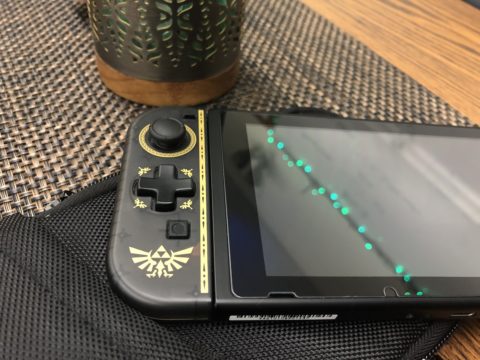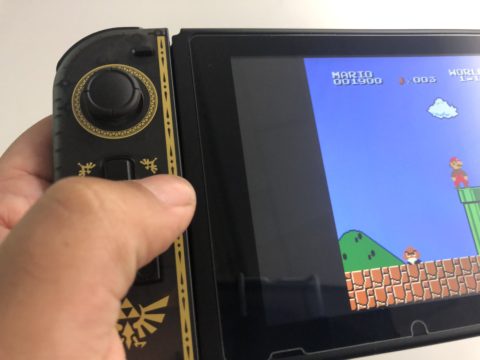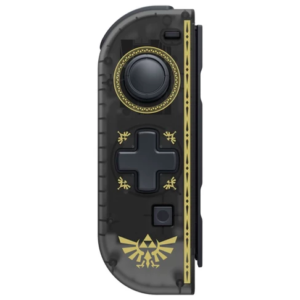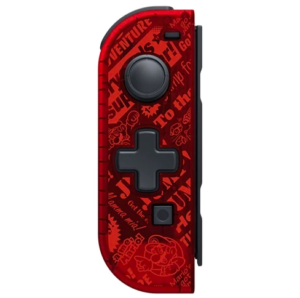Quality build; addresses the lack of a D-Pad that can sometimes be problematic with standard Joy-Con; seamlessly works with any Switch for most 2D games
Lacks a ton of stock Joy-Con features including rumble and motion controls; no internal battery means it can be played exclusively in handheld mode
It might be hard to believe these days, but there once was a time when most third party controllers were junk. Aftermarket pads generally are meant to serve as a budget alternative to the first party, high-priced offerings of console manufacturers but, back in the day, these controllers made it very obvious that they were the *ahem* cheap versions of the real thing. In the years since, however, third party controllers have taken leaps and bounds to improve themselves, now offering products that sometimes rival (and even occasionally surpass) what Nintendo, Sony, and Microsoft have for sale.
When Nintendo Switch was launched back in March of 2017, many fans were a bit miffed by the lack of a proper D-Pad on either the left or right Joy-Con, a first for any Nintendo console. The directional buttons on the left Joy-Con evoke the glory days of Nintendo 64, but they’re hardly serviceable for some of the more intensive platformers that Switch has to offer. While Nintendo has yet to officially produce a Joy-Con with a D-Pad, HORI has stepped up to the plate to do what Nintendon’t (couldn’t resist, sorry).
Some of you have doubtlessly seen the HORI D-Pad Joy-Con controller in stores like Target and GameStop and wondered whether or not the device is worthy of a purchase. It’s enticing, after all, as the controller clocks in at $25, making it far, far cheaper than a stock Joy-Con while also offering that all-important D-Pad. That said, there have also been rumblings from fans about the HORI D-Pad Joy-Con being a battery killer. With all that in mind, let’s break down HORI’s new pad and give you the proper 411 on what to expect once you’ve gotten one home and out of its box.

For starters, don’t fret about the battery-vampire reputation the HORI D-Pad Joy-Con quickly earned itself. While the moniker was deserved at first, that problem has been put to rest. The HORI D-Pad Joy-Con is officially supported by Nintendo, so while it wasn’t built internally, the Japanese company has kept a very close eye on the peripheral. Soon after the controller hit the Western market, a patch was put out to ensure that the HORI D-Pad Joy-Con would no longer siphon power from the Switch at an alarming rate.
For anyone wondering why the controller was sucking power like that in the first place, it’s because the HORI D-Pad Joy-Con has some key differences compared to a standard Joy-Con. The device is completely devoid of rumble, gyro controls, an NFC reader, and an internal power supply. Since the HORI Joy-Con requires being connected to a Switch for power, this also means the pad is incapable of being played in anything but handheld mode. That might sound whacky to some of you reading this, but in truth, the sacrifices made to get the HORI D-Pad Joy-Con operational are not deal-breakers.
Admittedly it can be a bit disappointing to see some of the key features of a regular Joy-Con absent from HORI’s, but the lack of these features does nothing to break the gameplay experience in most games. The HORI Joy-Con is all about providing precision control for fans who know that a D-Pad remains the standard bearer for 2D platforming games. Everything from Super Mario Bros. to Sonic the Hedgehog plays better with a D-Pad and the HORI Joy-Con allows gamers to experience these titles the way that they’re meant to be experienced.

At the same time, though, it can be frustrating that the HORI D-Pad Joy-Con doesn’t at least have an internal battery. At $25 it can arguably feel like the controller is still overpriced considering what doesn’t come in the box. Not being able to at least detach the HORI Joy-Con… well, it stinks. It’s as simple as that. Yet, despite this drawback, if thought about logically, it’s still not the end of the world for the HORI D-Pad Joy-Con. For fans playing on the go, outside of a Tabletop mode match of Super Mario Party, the Joy-Cons rarely if ever slide out of their rails. As such, it’s not much of a problem that the HORI Joy-Con isn’t self-powered considering it’s a feature most Switch users aren’t going to be impacted by.
In turn, once home, the Switch can be popped right into its dock, at which point a D-Pad clad Pro Controller (wired or otherwise) can then be used in lieu of the Joy-Con. After some thought, it seems that the only real losers in this scenario are fans who prefer to play with their Joy-Cons slipped into a grip, but beyond that, the HORI iteration still manages to be convenient. Perhaps of equal importance is the fact that the HORI Joy-Con feels great. It boasts a sturdy build and is almost a dead ringer for Nintendo’s own controller. The “minus” and “capture” buttons have a much spongier feel than Nintendo’s Joy-Con, but I personally enjoy the deeper depression the HORI versions afford.
Going back to how games play with this controller versus a regular Joy-Con, it’s astounding how much more natural so many 2D Switch games feel with HORI’s pad. Whether it’s the golden oldies available from the Nintendo Switch Online library or even more modern titles like Hollow Knight, playing with the HORI D-Pad Joy-Con is now my preferred way of playing while on the go. It’s important to note that not every game works perfectly with the HORI Joy-Con. Some fighting games, for example, don’t feel quite as suited to how the HORI D-Pad is situated on the controller itself. It’s the sort of complaint that most people likely won’t even notice while playing, but for those who are hyper-tuned to the performance of every inch of their controllers, try to give the HORI Joy-Con a whirl before making a purchase.
If one wants to really nitpick, though, there is a problem that can’t be rectified when it comes to the HORI D-Pad Joy-Con, which is that there’s no way to assemble a matching pair! These are only offered for the left-hand side and not the right, meaning anyone who wants to be “matchy-matchy” with their Joy-Con is going to be out of luck. At present there are three versions of the HORI pad to choose from (Super Mario, The Legend of Zelda: Breath of the Wild, and Pikachu), which you can see above. All three are very cool, but tragically, as previously noted… there’s no matching friend to slip into the right track of a Switch. Bummer.
Overall, the HORI D-Pad Joy-Con is a winner. It offers a sturdy build alongside the much-demanded D-Pad that so many fans have wanted since Switch first was announced. While the HORI D-Pad itself does lack many of the features of a standard Joy-Con, there are very few occasions when their absence is problematic to gameplay. Outside of a handful of games, the HORI Joy-Con is a wonderful, cheap alternative that also provides players with the style of control that they need to get the most out of countless 2D platformers available for Switch.




 ShareThis
ShareThis








